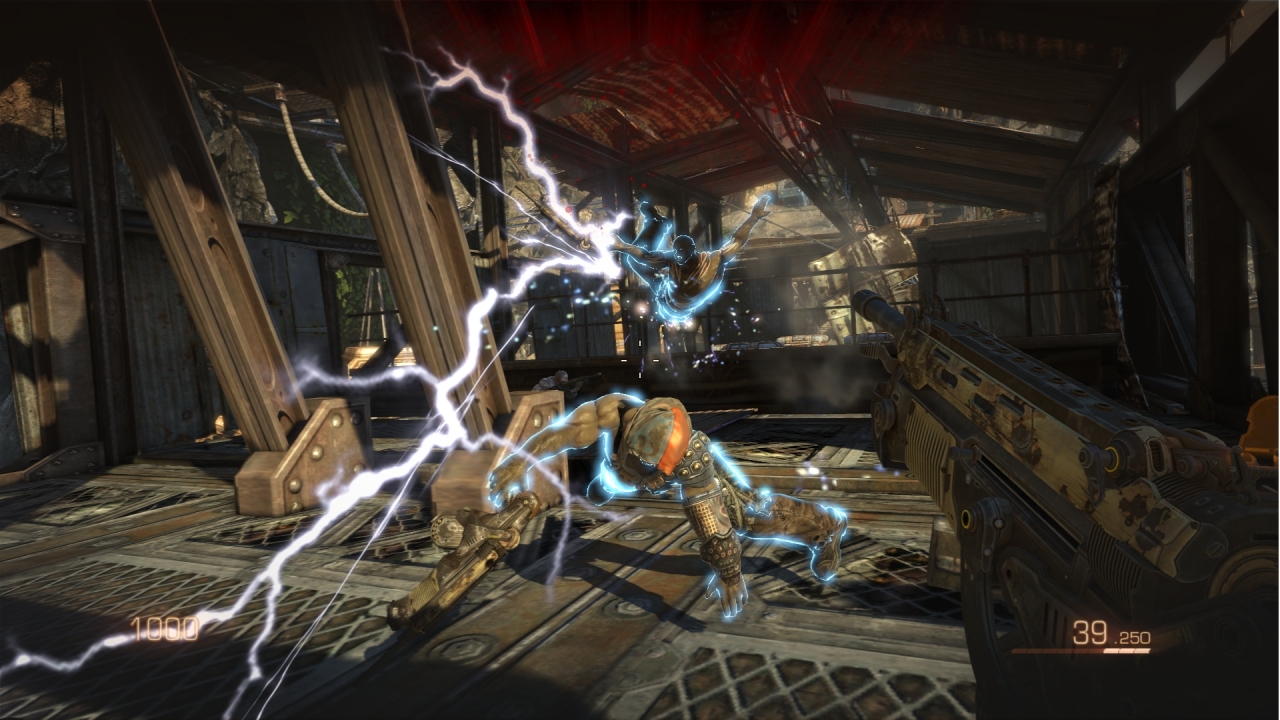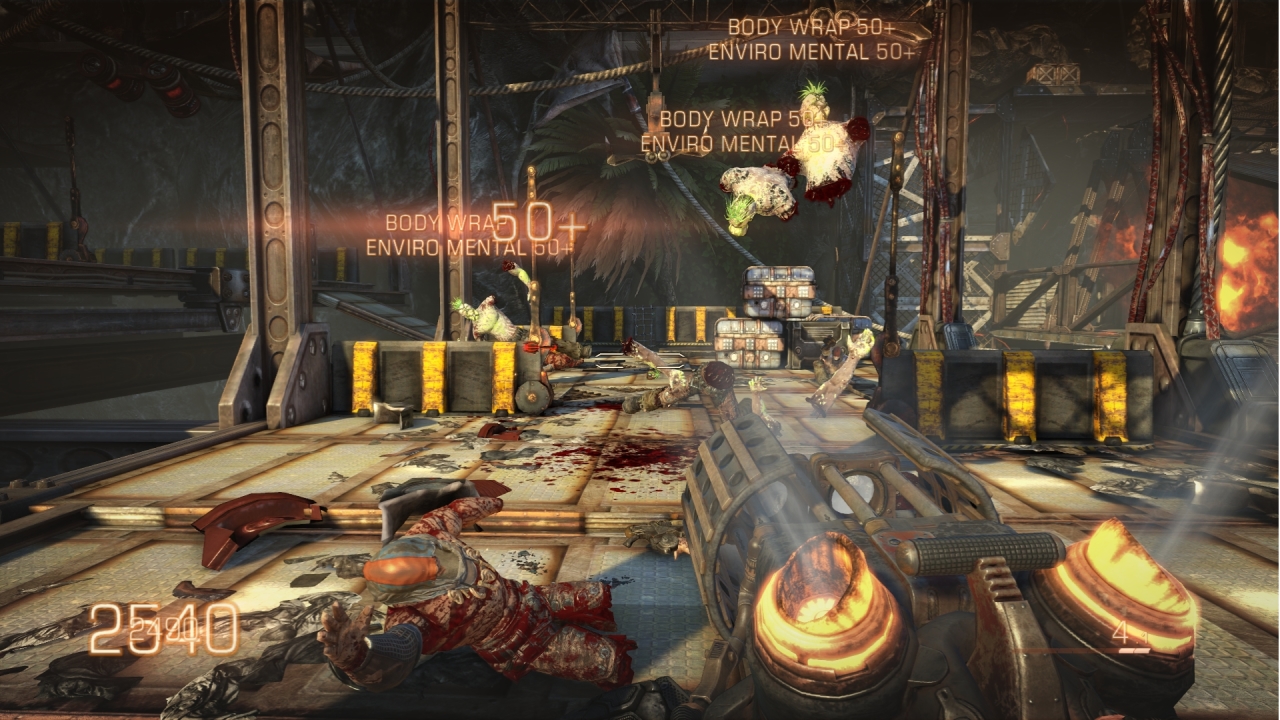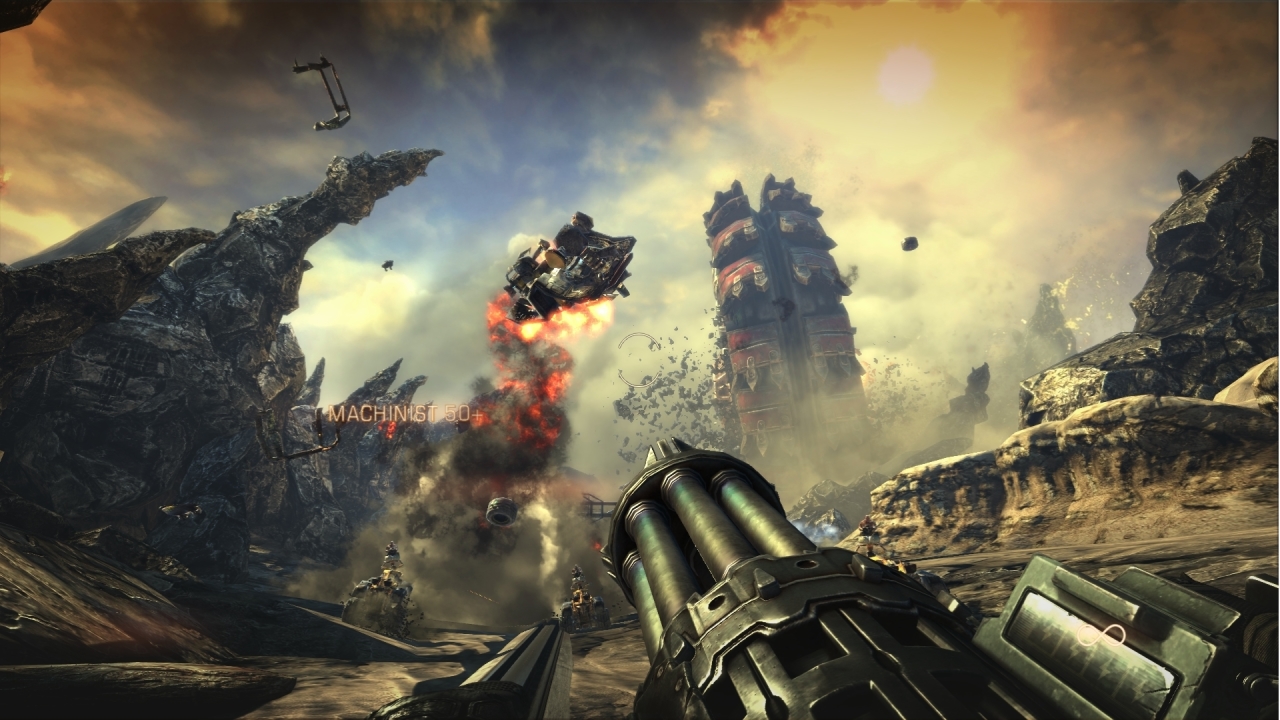Bulletstorm Review
 Game: Bulletstorm
Game: Bulletstorm
Developer: People Can Fly
Publisher: Electronic Arts
Available on: Xbox 360, PlayStation 3 and PC (Xbox 360 version reviewed)
Forget money. When they were riding the ankle deep cocaine powder of the glamourous 1980’s only two things really mattered to people: high scores and swearing. The arcades ruled the gaming scene as the war for the highest score on Donkey Kong started in earnest. The Young Ones, literally, smashed their way onto your TV and introduced you to some poetic violence mixed with some deft bad language.
People Can Fly have decided 2011 is the perfect time to fuse this high score hunger and boundary defying swearing with the lavish excess of today’s modern technology. In many way this game is the 80’s dream made real.
But is that enough? Do players still want to chase high scores and laugh along whilst someone plays the “make up the stupidest word for tits” game we all enjoyed so much in GCSE Spanish? Even more pertinent; is there more to this game than meets the eye? Does it offer more to modern gaming than it might appear at first glance? Read on to find out.
STORY: Space pirates, maniacal generals, pleasure planets; it’s all going on for Grayson Hunt and his crew. Established immediately as a tale of revenge, Bulletstorm deserves praise for using back story sequences and exposition as a chance to deliver an exciting tutorial, all whilst cluing the player into the motives behind its main characters. The main body of the story is little more than a great excuse to get the characters onto one of the more varied and interesting game worlds in recent memory, but it is told so whole-heartedly that it would be a lie to say it was anything less than a profane riot.
Unfortunately, the game somewhat forgets itself towards the end and the dialogue gets a little too ham-fisted and emotional, particularly in comparison to the anarchic banter that filled the first ninety percent of the action. Whilst going into more detail would be too spoiler-rific for this review, lets just say that expect a lot of characters to tell you exactly what they are feeling and why they are feeling it, rather than just let their actions speak for themselves. It is alright for a game to have a stupid concept and tell it in a funny and light-hearted way, it is far less ok for the game to start treating the player like they are stupid.

GRAPHICS: Without wanting to sound like a jaded old graphics whore, you know what to expect from the Unreal Engine by now. Worlds are stunning, with views and scenery that stretch way into the distance. The planet that the player must fight across is gloriously varied, switching from precarious rooftops to radioactive caves that look magnificent throughout.
Where the game exceeds expectations is through the detail of the environments. Levels do a superb job of seeming busy and alive. Dust floats to the floor, explosions are vivid and, in keeping with the game’s ultra violent motif, utterly visceral. The sections where large objects are on the move are all incredibly immersive (to say any more would spoil some of the game’s better surprises) and, overall, this feels like a superb evolution for the Unreal technology.
SOUND: Audio quality in Bulletstorm consummately equals that of the visuals. Voice acting is funny and well delivered, with the performers throwing themselves into even the most ridiculous swearing fits with humour and commitment.
Surround sound effects pitch and roll around the character as they should and, despite the amount of enemies getting blasted to pieces, the sound effects remain a constant, disgusting reminder of your skillshot savagery. Which is, of course, a very good thing.
GAMEPLAY: Despite the leash (the lightening blue attachment that players use to manipulate and throw enemies), the weapons and the brutal environment, Bulletstorm doesn’t offer anything that we haven’t seen in a number of other games. Many games have given players many tools to kill enemies and have encouraged experimentation. What People Can Fly’s game offers the player, through skillshots and the ever climbing score total, is a way of quantifying your success and giving immutable proof to your imagination and technique as a blood hungry killing machine. Whatever method of death your filthy mind can conceive Bulletstorm can attach a score to, and this creates an experience that feels unique in the po-faced world of current FPSs. Other games let you experiment, Bulletstorm exists so that you do. It is a subtle difference, but an important one.

It is a shame that the game is a slow starter. Weapons and upgrades are accessed through Dropkits scattered throughout the levels and, for quite some time, players don’t have access to all of the kit. Added to that, additional ammunition, charge shots and thumpers are all accessed by spending the skillshot points accumulated since the last drop kit. These factors combine to restrict the number of skillshots available to the player and, particularly when compared to the Echoes mode, reduces opportunities to experiment. Once the story is a few hours old and you have access to all of the tools then the game really hits its straps, allowing players to juggle weapons and ammunition types, discovering and executing skills shots to their hearts content. Only then are you playing Bulletstorm fully formed. It is a shame that you are made to wait so long for incredible entertainment to get into full swing.
It must be said that the game is staggeringly linear. Not only is their one path through a level, it is usually a very narrow one. Low set scenery like rocks is almost always impassable and with no jump button levels often feel cramped and tight, despite great pains taken by the developer to show off incredible vistas at every available opportunity. The advantage of these tight play areas is that enemy encounters are always taut, exciting and, most importantly, brilliantly tuned to maximise skillshot opportunities. The disadvantage is that players can feel hemmed in and the world loses any sense of being a playground and a place to explore. In the context of Bulletstorm, these levels work as the freedom of movement and exploration is traded in for the ability to truly explore the art of killing. However, those in love with the open play spaces of Halo, for example, could find Bulletstorm’s tight corridors a little too claustrophobic.
LONGEVITY: Bulletstorm is an unusual beast in a lot of ways. None more so than the nagging sense that this is a game that improves once you have got the story mode out of the way.
Echoes mode is Bulletstorm at its apex. Trimming back cut-scenes and freeing the player from the need to purchase munitions with skillpoints. It’s a mode that is solely about finding ways to maximise your points over short five minute slices of the game. Like finding the perfect racing line in Gran Turismo 5 or sneaking a couple more hits into a combo in Street Fighter IV, digging the extra skillshots and points out of an Echo is the sort of challenge that, in an 80’s arcade, would have seen you piling coins on top of the machine and burning the retina out of your eyes as you hogged the the hot seat as long as you could. Online leaderboards provide the markers by which you judge your success. Once Echoes takes over your playing of the game you go beyond just experimenting with weapon load outs and skillshots, you start to perfect your run, execute moves with precision and skill and obsess about every second you can save. It is a sense of learning and progression more associated with a football title or hardcore beat-em-up rather than a mode in single player shooter, and it works superbly.

The multiplayer mode, Anarchy, is a simple concept with a twist. You join a team of four and kill as many enemies as you can, but waves are only cleared by killing all the enemies and getting a high enough team skillpoint total. Easy at first, Anarchy quickly racks up the required points and forces players into some pretty elaborate team killing. The skillshot encyclopaedia grows with moves like “Double Penetration” and “Das Boot”, and players are consistently rewarded for working together. This, of course, is a blessing and a curse. If you get into a good game with players who want to chat, work together and get team bonuses, the game is great. Find a group of individuals flying about and doing their own thing and, frankly, it is time to go back into Echoes mode. Anarchy is fun, but it is too ‘one note’ to enjoy with people who aren’t interested in changing their style from how they might play Call of Duty or Gears of War. This isn’t a criticism of Bulletstorm, the developers can’t choose who plays. The criticism comes from the fact that currently in the game there are no online alternatives to Anarchy mode. The developer has taken a big risk by not including a competitive multiplayer option and, as such, online experience is going to be dictated by who is searching for a game when you are.
VERDICT: Apart from a couple of brief lapses, Bulletstorm is a game that knows precisely who and what it is: a glorious throwback dressed in all of our modern finery. An obsession with points and leaderboards certainly, but also with experimentation and refining of a craft.
The biggest surprise is perhaps the best. Once you peel back the layers of the swearing and bravado you find that this a game that gets better and more involving the more you play.
So maybe the 80’s and Bulletstorm aren’t so similar. That decade gets more embarassing and distant as time passes, People Can Fly’s new game gets better with age. Who would have thought it?!






